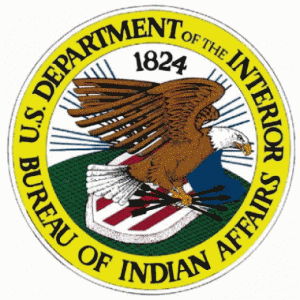 In honor of Native American Day (a state holiday that will be observed in California and Tennessee tomorrow, September 28, and in South Dakota on October 8), we’re focusing this week on two federal agencies that serve Native Americans: the Bureau of Indian Affairs (BIA), which is the oldest bureau in the U.S. Department of the Interior, and the Indian Health Service (IHS), which is part of the U.S. Department of Health and Human Services. And just in case you’re wondering whether it’s politically correct to refer to the approximately 1.9 million Native Americans as anything other than that, the BIA offers this advice:
In honor of Native American Day (a state holiday that will be observed in California and Tennessee tomorrow, September 28, and in South Dakota on October 8), we’re focusing this week on two federal agencies that serve Native Americans: the Bureau of Indian Affairs (BIA), which is the oldest bureau in the U.S. Department of the Interior, and the Indian Health Service (IHS), which is part of the U.S. Department of Health and Human Services. And just in case you’re wondering whether it’s politically correct to refer to the approximately 1.9 million Native Americans as anything other than that, the BIA offers this advice:
“When referring to American Indian or Alaska Native persons, it is still appropriate to use the terms ‘American Indian’ and ‘Alaska Native.’” The former term refers to persons belonging to the indigenous tribes of the continental United States, while the latter refers to those who belong to the indigenous tribes and villages of Alaska (including Eskimos, Aleuts and Indians).
Secretary of War John Calhoun established the BIA within the War Department on March 11, 1824; Congress transferred it to the newly created Interior Department in 1849. Today, Indian Affairs provides services to American Indians and Alaska Natives belonging to one of 566 federally recognized tribes. It is made up of two bureaus: BIA, which is responsible for the administration and management of approximately 56.2 million surface acres and 57 million acres of subsurface mineral estates held in trust by the nation, and the Bureau of Indian Education (BIE), which provides educational services to about 42,000 Indian students. Indian Affairs headquarters are located in the Department of the Interior headquarters building at 1849 C Street, N.W., in Washington, D.C. The agency is led by Assistant Secretary for Indian Affairs Kevin Washburn, a member of the Chickasaw Nation of Oklahoma, whose nomination was confirmed by the Senate just last week (on Friday, September 21).
The United States has a unique legal and political relationship with its Indian tribes, as provided for by the U.S. Constitution, treaties, court decisions and federal statutes. The land that the nation holds in trust for various tribes and individuals includes more than 320 federal Indian reservations. The smallest of these is a 1.32-acre site in California that houses the Pit River Tribe’s cemetery; the largest is the 16 million-acre Navajo Nation Reservation that spreads across parts of Arizona, New Mexico, and Utah. While American Indians and Alaska Natives pay most of the same taxes as other U.S. citizens, they do not pay local property taxes on reservation or other trust land.
BIA also maintains a government-to-government relationship with federally recognized tribes and promotes and supports tribal self determination. BIA services are administered by 12 regional offices located in Aberdeen, S.D.; Albuquerque and Gallup, N.M.; Andadarko and Muskogee, Okla. Billings, Mont.; Bloomington, Minn.; Juneau, Ala.; Nashville, Tenn.; Phoenix; Portland, Ore.; and Sacramento, Calif. These regional offices—and 83 agencies located within reservations—all report to the BIA deputy director of field operations in Washington, D.C.
Indian Affairs has more than 8,000 full-time employees. President Obama’s FY2013 budget request for both BIA and BIE is $2.63 billion, about $110 million less than the FY2012 enacted budget of $2.74 billion.
